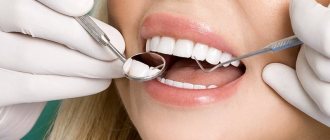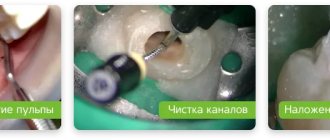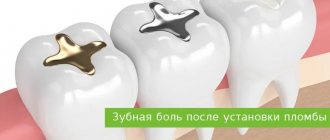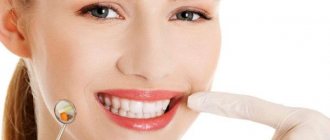Sometimes, after dental treatment, patients go to the dental clinic with a complaint of pain, not knowing that pain after some dental procedures is a normal phenomenon, and only in rare cases does it serve as a warning sign.
What causes pain after dental treatment and what to do in this situation?
If the filling interferes after treatment
Even in the doctor’s office, after installing the filling, be sure to make sure that the restored tooth is not in the way (move your jaw back and forth, sideways, carefully close your teeth). The filling should not be felt or change the bite. Don’t be shy about talking to your doctor about any discomfort—sometimes the final stage of filling treatment can take even longer than removing cavities and applying filling material.
After treatment, anesthesia wears off within 1.5-2 hours. If a conductor type was used, then after 4-6 hours. Now you are beginning to fully feel the treated tooth, you can fully close your jaws and understand how comfortable you are after filling.
If you experience slight discomfort, it feels like the tooth is a little larger and your jaws aren't closing quite tightly—this is normal. The fact is that now you have been given a new filling in accordance with the bite, that is, with the shape and position of the tooth located on the opposite side. The treated tooth became taller than before - after all, there was caries and the old filling sagged. Therefore, if there is no sharp pain and obvious rejection, be patient for a few days. If the situation normalizes and you get used to it, then there is no reason to see a doctor. If discomfort persists for 1-2 weeks, you should visit your dentist to have the filling corrected.
Classic filling
The conventional filling procedure does not imply penetration into the tooth pulp and depulpation of the root canals. This manipulation is much simpler compared to endodontic intervention, however, not everything is so obvious here. First, conventional therapeutic procedures are performed more frequently. Secondly, the quality of materials and the level of specialists in Russia are often low, so severe pain after filling a tooth and other complications are by no means uncommon even with the simplest manipulations. Below is a table that describes the most common causes of complications and pain after filling.
| Type of complication | Description | Pain symptoms |
| Mechanical trauma to the pulp during filling (pulp perforation) | It occurs when the bur is used roughly and carelessly, when the partition between the pulp and dentin is destroyed. Modern dentistry offers conservative ways to eliminate such complications, but often only a depulpation procedure can help. | With this problem, the tooth “pulsates” after filling and reacts sharply to cold and hot. The pain is severe and practically does not subside. |
| Burn of dentin or pulp (tooth overheating) | Usually occurs when the cooling system of the drill malfunctions, when the tooth tissue gets burned during the operation of the drill. In the most severe cases, the patient develops pulpitis and periodontitis. | If your tooth ache after filling and the pain does not go away for a long time, it is quite possible that you have a dentin burn. If, after filling, the tooth reacts sharply to hot and cold or there is throbbing pain, then most likely the pulp was affected. |
| Incorrectly installed seal | Overbite and overhanging filling edges are among the most common causes of pain. Incorrect closure of the dentition provokes very unpleasant sensations. | Does your tooth hurt when you bite it after filling? Perhaps the problem is an incorrectly installed seal. If the cause is not eliminated in time, the tooth reacts painfully even with gentle pressure. |
| Error when choosing material | There are more than a dozen filling materials on the market, many of which are not suitable for everyone due to their properties and components. | Acrylic composite and silicate cement fillings can cause allergies and inflammation. Amalgams and some light fillings can shrink, which is why the tooth hurts quite noticeably when bitten after filling. |
| Gum injuries | Damage to soft tissue is a very common occurrence during therapeutic manipulations (especially in the treatment of cervical caries). Serious injuries may require gum grafting. | Aching or cutting pain at the site of gum damage. |
How long should you not eat after having a filling installed?
If a filling made of chemical composites is installed, then you should refrain from eating and drinking for 2 hours. This is due to the fact that the material requires a certain time for final shrinkage and hardening.
If a “light” composite filling is installed, you can drink immediately, but you should abstain from food for 1.5-2 hours. But the reason is not in the material (it hardens a few seconds after application), but in anesthesia - with reduced sensitivity of the mucous membranes during eating, you can injure the tongue and mucous membranes of the cheeks on the inside.
During the day after the filling is installed, you should only eat warm foods - excessively hot or cold foods can lead to changes in the shape of the filling. It is necessary to chew food on the opposite side for the first day - this will allow the material to fully “adhere” to the tissues and take the desired shape, without the risk of damage.
What to do after removal?
After tooth extraction, it is important to maintain proper oral hygiene and also slightly limit your diet. The main recommendations are:
- You can apply a cold compress to the damaged gum, which will reduce the pain;
- if the bleeding does not decrease, you can firmly press a cotton swab between the teeth in the area of tooth extraction;
- For disinfection, rinses based on natural herbs should be used;
- It is better to eat only warm and soft foods without solid particles.
Medications can also be used to reduce discomfort. However, you can only use those medications prescribed by your doctor. He should also tell you how long to rinse so as not to damage the wound.
If at any stage of healing the patient feels an increase in pain symptoms or discomfort that is not normal, he should immediately inform the doctor.
Why does a tooth hurt after a filling is installed?
Minor soreness may persist for several days or even a couple of weeks, which is explained by overheating of the tissue due to the use of boron. In some situations, for example, with deep caries or when treating front teeth, increased sensitivity can persist even for several months. But in such a situation, you should still consult a doctor for an x-ray to make sure that there is no infected tissue left under the filling and that inflammation has not affected the nerve.
If the pain intensifies, the filling darkens, black spots appear under it - all this indicates that the treatment was carried out poorly and re-inflammation has begun. This is a reason to see a doctor as soon as possible.
Why is temporary filling needed?
The need to use filling material is determined by the dentist. The installation of a temporary filling is prescribed by a doctor in the following cases:
- Carrying out diagnostics. When treating a patient with deep caries, a specialist is not always able to determine the extent of tissue damage. The doctor cleans the tooth cavity and places filling material. If the neurovascular bundle is not inflamed, then after the procedure the person will not experience pain. If the dental nerve and surrounding tissues are damaged, preliminary treatment will be required.
- Removal of the neurovascular bundle. In some cases, nerve sacrifice is required before removal. To do this, the dentist puts a specialized paste into the tooth cavity. After a certain period of time, the specialist removes the pulp and fills the tooth cavity with permanent filling material.
- Dental prosthetics. The dentist prepares teeth for prosthetics. To ensure that the root canals are protected from food and pathogenic bacteria during manufacturing, the specialist places a temporary filling material into the tooth cavity.
- Treatment of diseases. After treatment, the dentist places medications into the tooth cavity. After a certain period of time, the specialist removes the temporary filling and installs a permanent filling.
What to do if your gums hurt after filling
The gums in the area where the anesthesia was administered may ache for several days - this is completely normal and does not require any measures. The mucous membrane may also be slightly inflamed if special rings were used during treatment, which are placed on the tooth to form the correct shape of its crown. The gums can also be damaged if the doctor had to install the filling material in close proximity to the mucous membrane or even under it - in such a situation the gums are deliberately pushed back. Therefore, pain is a normal reaction to external intervention.
All of these conditions are variations of the norm. But if the pain intensifies, redness and swelling of the mucous membrane progresses, you need to consult a doctor.
How long can you walk with a temporary filling?
The material used for temporary filling is highly durable. The filling does not break down for a long time. The specialist determines the period of wearing temporary filling material based on the nature and degree of neglect of the disease. The duration of wearing the filling is individual for each patient.
At the end of the established period, the person must immediately contact a specialist. An increase in the time period can lead to the development of diseases. In some cases, the filling may crumble at the end of its period, and the drug will negatively affect the patient’s body.
How to properly perform hygiene procedures
After treatment, brush the filled tooth carefully, applying minimal pressure to it. Do not use rinses containing abrasive substances and alcohol, which can increase the plasticity of the material - this will lead to a change in the shape of the filling. Also, do not use excessively hard brushes - they can leave microcracks in the material, which will quickly damage it.
In general, you should take care of teeth with fillings in a completely standard way:
- daily brushing of teeth twice a day - in the morning before breakfast and in the evening after all meals, after - rinsing the mouth with water and rinse,
- To clean the area of filled teeth after eating, it is better to replace dental floss with an irrigator. If you floss carelessly, you can touch the installed filling, especially if there are thin edges of the tooth, which will lead to its loss.
Why is tooth extraction required?
In certain cases, tooth extraction is the only possible method of solving a particular dental problem. Indications for removal may include:
- Incorrect position of the tooth, when neither the patient nor the doctor can access it (high-quality hygiene and/or treatment is impossible);
- The absence of the main part of the dental material without a chance of its restoration;
- Malocclusions (for example, severe crowding);
- Inflammatory process in the roots of the tooth, which can lead to infection;
- Painful eruption of wisdom teeth.
This is also necessary when preparing to correct your bite using Invisalign aligners. In particular, it is usually necessary to remove the “eights” if they have not fully erupted and can interfere with quality orthodontic treatment. It is worth noting that such a decision should be prepared when there are certain indications and no other option is possible.
Otherwise, when installing aligners, the unerupted tooth hidden inside the gum will prevent the aligner from attaching and pull the remaining teeth in the right direction, leaving them no room to move.
Is it necessary to follow a diet after caries treatment?
From the diet as a whole after caries treatment (especially if a large filling is installed and your own tooth has very thin walls), it is recommended to remove too hard foods - toffees, chewing gum, grilled fruit, nuts, etc. Or chew them with teeth located on the opposite side (if they do not have fillings).
Minimize the amount of consumed foods and drinks that contain coloring pigments (tea, coffee, beets) - under their influence, the filling material may slightly change its shade. This rule is especially relevant when restoring front teeth.
Why do patients experience pain after caries removal?
The Nurimed Clinic provides highly qualified treatment for dental caries, but even our specialists cannot promise the absence of pain after therapy, since much depends on the individual characteristics of each patient.
The main factors contributing to the occurrence of pain syndrome:
- Excessive drying of the tooth before placing a filling. Before completing caries treatment, the doctor etches the enamel with a special compound, which is then washed off and the dentin is dried. When the tissue is overexposed, its natural moisture is lost, which subsequently leads to pain.
- Insufficient tooth drying. Remaining moisture on the dentin leads to the fact that the filling is not fully and correctly attached. In such situations, it is very likely to be torn off, and the tooth will be disturbed under vertical loads (chewing).
- Relapse of the carious process. Caries is an infectious disease caused by pathogenic flora. Doctors are not always able to completely get rid of bacterial pathogens, which is why pain appears again some time after treatment.
- Complications after caries. Even after treatment, it cannot be guaranteed that the carious process has not reached the pulp or periodontium. The pain process can be triggered by an exacerbation of the inflammatory process in these areas.
- Incomplete removal of the neurovascular bundle (pulp). Even X-ray studies can give false information, so remnants of nerve endings cannot always be removed immediately. This is especially true for people with branchy and deep roots.
- Exit of the filling into the periapical area. A rare complication, since all procedures in modern dentistry are performed under radiographic control.
- Presence of air in the filling. The nerve endings are irritated, which causes pain. The problem arises when the filling installation technique is violated.
- Breakdown of instruments. In some cases, in patients with branched and deep roots, instruments break when extracting the pulp. If the debris has not been removed, then an inflammatory process gradually develops, which is accompanied by pain.
- Intolerance to the components of the filling or any other substances used in treatment. The pain syndrome in such cases is caused by severe swelling.
In addition to these common causes, pain can be caused by errors in treatment, in particular, irritation of the pulp by a specific acid used to etch the enamel.
Only a dentist can accurately answer the question of why pain occurs after caries treatment, so you should not put off visiting him.
How to maintain your treatment guarantee
As a rule, therapeutic treatment, that is, dental filling, is guaranteed from 6 months to 2 years - depending on the volume of work and the complexity of the situation. To maintain the guarantee, the patient must strictly follow all recommendations: do not overload the tooth, do not use it for other purposes (for example, open beer bottles), and also regularly see the doctor in accordance with the individual schedule of medical examinations. Unfortunately, many patients forget about this, and it is the last point that is the key to maintaining the guarantee for treatment.
You need to visit a doctor 1-2 times a year. During a preventive examination, the dentist will be able to make sure that the filling is in good condition and that caries does not develop again underneath it.
How to cope with pain?
In the fight against pain, it is not recommended to use untested folk remedies, especially if alarming symptoms develop. If you are not sure whether your feelings are normal, make an appointment with your dentist or consult with him by telephone.
To eliminate pain, special medications prescribed by the doctor are suitable. These most often include drugs from the group of non-steroidal anti-inflammatory drugs, for example, Ibuprofen, Nise, Nimesulide and others.
The medications are taken strictly according to the instructions and recommendations of the dentist. Additionally, cold compresses can be used.











